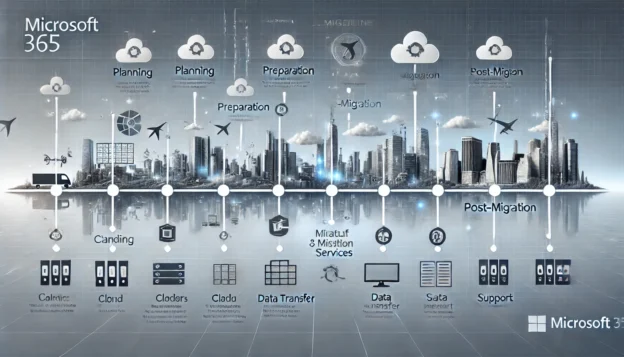Successfully migrating multiple Microsoft 365 tenants into a single tenant requires a well-structured timeline and careful planning. This guide outlines a week-by-week approach to managing the migration process, from initial assessment to ongoing support, helping organizations navigate the complexities of tenant consolidation.
Introduction
Migrating multiple Microsoft 365 tenants into a single, unified environment is a significant undertaking that demands meticulous planning and execution. The timeline for such a migration can vary widely depending on factors like the size of the tenants, the number of users, and the complexity of the data being migrated. This article presents a structured timeline to guide organizations through the process, ensuring that each stage, from planning and preparation to post-migration support, is handled effectively.
By following this timeline, organizations can reduce the risks associated with tenant migration, minimize downtime, and ensure a smooth transition for all users involved. The guide also offers flexibility to adjust the timeline based on the specific needs and challenges that may arise during the migration process.
The Timeline
The timeline for migrating multiple Microsoft 365 tenants into a single tenant depends on several factors, including the size of the tenants, the number of users, the amount of data to be migrated, and the complexity of the environment. Below is a general timeline that can be adapted based on the specifics of your situation:
Week 1: Planning and Preparation
- Day 1-3: Initial Assessment
- Review the current setup of all tenants.
- Identify the data and resources to be migrated (users, mailboxes, SharePoint sites, OneDrive, Teams, etc.).
- Determine licensing requirements for the target tenant.
- Identify any custom domains and prepare DNS changes if necessary.
- Day 4-7: Migration Planning
- Create a detailed migration plan, including timelines, resource allocation, and communication strategies.
- Choose migration tools (e.g., BitTitan, Quest) if needed.
- Plan for pilot migrations to test the process.
Week 2: Preparation and Pilot Migration
- Day 8-10: Target Tenant Preparation
- Configure the target tenant (
@webinar.onmicrosoft.com) to receive data and users. - Set up necessary licenses and permissions.
- Configure the target tenant (
- Day 11-14: Pilot Migration
- Perform a pilot migration with a small group of users or data to ensure the process works smoothly.
- Address any issues encountered during the pilot.
- Update the migration plan based on the pilot results.
Week 3: Full Migration of Users and Mailboxes
- Day 15-18: User and Mailbox Migration
- Migrate users and mailboxes in batches.
- Monitor the migration process closely and resolve any issues as they arise.
- Communicate with users about the migration process and expected changes.
- Day 19-21: Verification and Testing
- Verify that all users and mailboxes have been successfully migrated.
- Test access to mailboxes, OneDrive, SharePoint, and Teams for all users.
- Resolve any issues identified during testing.
Week 4: Migration of Other Resources (SharePoint, OneDrive, Teams)
- Day 22-24: SharePoint and OneDrive Migration
- Migrate SharePoint sites and OneDrive data using the SharePoint Migration Tool (SPMT) or third-party tools.
- Verify the integrity and accessibility of the migrated data.
- Day 25-27: Teams Migration
- Migrate Microsoft Teams data, including channels, chat history, and files.
- Test Teams functionality and ensure that all data is correctly migrated.
- Day 28: Final Verification
- Conduct a final review of the entire migration process.
- Ensure that all users have access to their data and that all services are functioning correctly.
Week 5: Post-Migration and Decommissioning
- Day 29-31: User Training and Support
- Provide training and support to users as they adapt to the new setup.
- Address any remaining issues and ensure a smooth transition.
- Day 32-35: Decommission Old Tenants
- Remove any residual data from the old tenants.
- Decommission the old tenants by canceling subscriptions and ensuring no active services remain.
- Update DNS records to reflect the new tenant configuration.
- Day 36-37: Final Review and Documentation
- Document the migration process, including any challenges faced and how they were resolved.
- Perform a final audit to ensure everything is working as expected.
Week 6: Ongoing Monitoring and Support
- Day 38-42: Ongoing Monitoring
- Continue to monitor the target tenant for any issues that may arise.
- Provide ongoing support to users as needed.
Adjustments Based on Complexity
- Smaller Tenants: If the tenants are small with few users and limited data, the timeline might be shortened to 3-4 weeks.
- Larger Tenants: If there are many users, large amounts of data, or complex integrations, the timeline could extend to 8-10 weeks or more.
- Unexpected Issues: Always plan for some buffer time in case of unexpected challenges during migration.
This timeline is a general guide. It’s important to remain flexible and adjust the schedule based on the actual progress and any issues encountered during the migration process.
Conclusion
A successful Microsoft 365 tenant migration hinges on careful planning and a clear timeline. By breaking down the process into manageable steps and addressing potential challenges early on, organizations can ensure a smooth and efficient migration. Whether dealing with small or large tenants, this guide provides the framework needed to navigate the complexities of tenant consolidation, ultimately leading to a more streamlined and unified Microsoft 365 environment.
References
- Microsoft 365 Documentation – Tenant-to-Tenant Migration Guide
- SharePoint Migration Tool (SPMT) – Microsoft SharePoint Migration Tool
